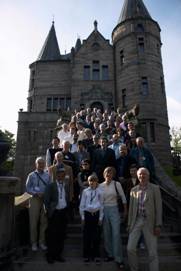Quantum Information/Computation Quantum Probability Quantum Voting Mathematics
Quantum Probability
 Classical probability theory for martingales (stochastic integration) is traditionally based upon a probability space (Ω, F, m) consisting of a sample space Ω, a sigma algebra of subspaces of the sample space and a probability measure m together with a filtration { F_t}, t ≥0 consisting of complete sigma - subrings of F. A conditional expectation operator E ( . | F_t ) is employed mapping functions integrable with respect to F to functions integrable with respect to F_t. A martingale is then a process X_t such that for all t' ≥ t, E (X_t'| F_t) = X_t.
Classical probability theory for martingales (stochastic integration) is traditionally based upon a probability space (Ω, F, m) consisting of a sample space Ω, a sigma algebra of subspaces of the sample space and a probability measure m together with a filtration { F_t}, t ≥0 consisting of complete sigma - subrings of F. A conditional expectation operator E ( . | F_t ) is employed mapping functions integrable with respect to F to functions integrable with respect to F_t. A martingale is then a process X_t such that for all t' ≥ t, E (X_t'| F_t) = X_t.
Reformulating the theory in terms of the Hilbert space L^2(Ω, F , m) with associated filtration L^∞(Ω, F_t , m), (a von Neumann algebra filtration) and conditional expectation (projection) from L^2(Ω, F , m) to L^2(Ω, F_t , m) one may develop a quantum analogue of the classical construction based, for example, on Irving Segals probability gage space (H, A, m) consisting of a Hilbert space H, a von Neumann algebra A, a filtration of von Neumann algebras { A_z}_z and gage m. We consider non-commutative constructions in Clifford and Quasi-Free settings resulting in orthogonal, centred L^2 martingales, obeying isometry properties as stochastic integrals.
Representation theorems for such martingales have been established and research is actively being pursued in this and related areas of probability theory.
Continued ...